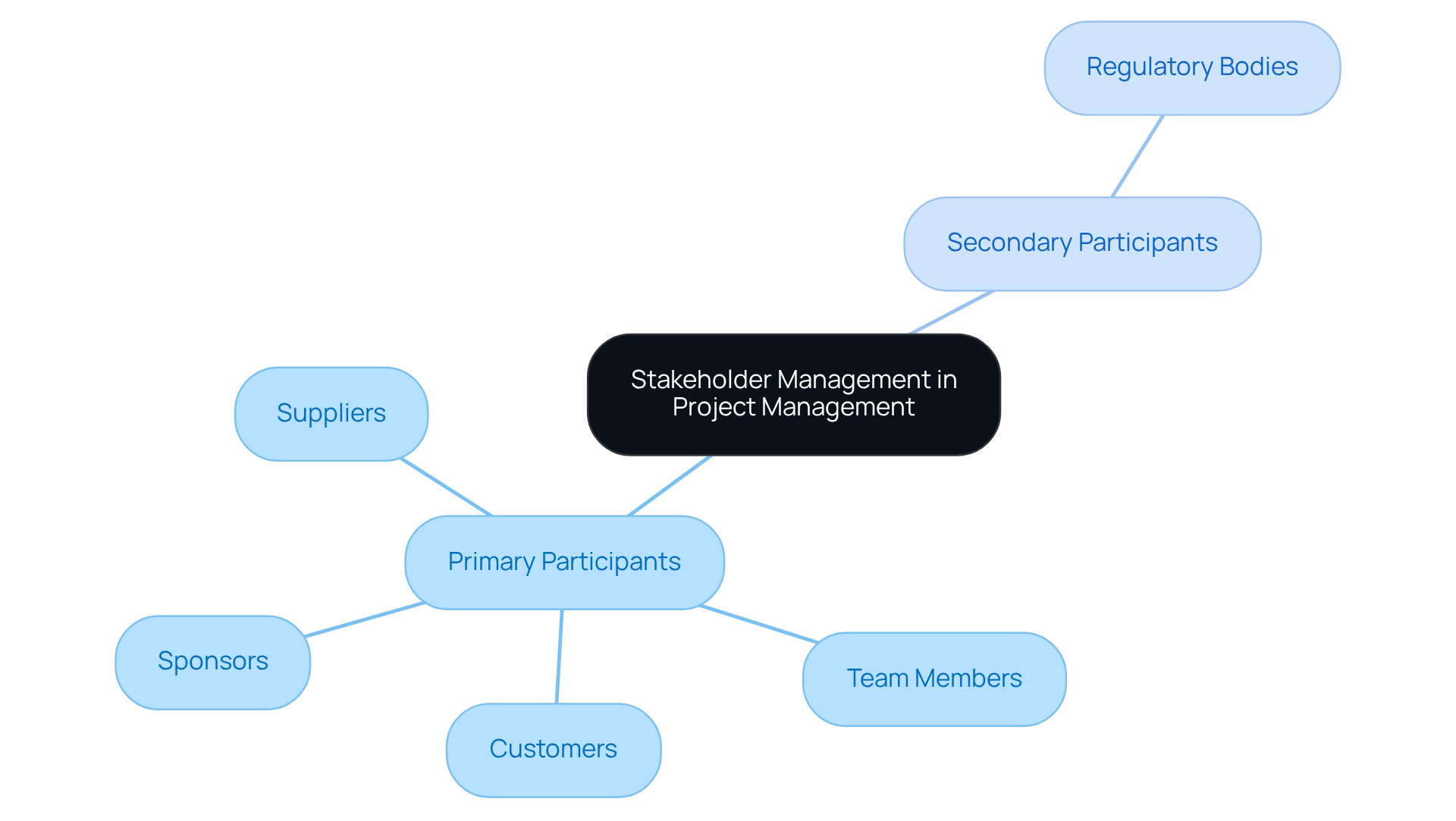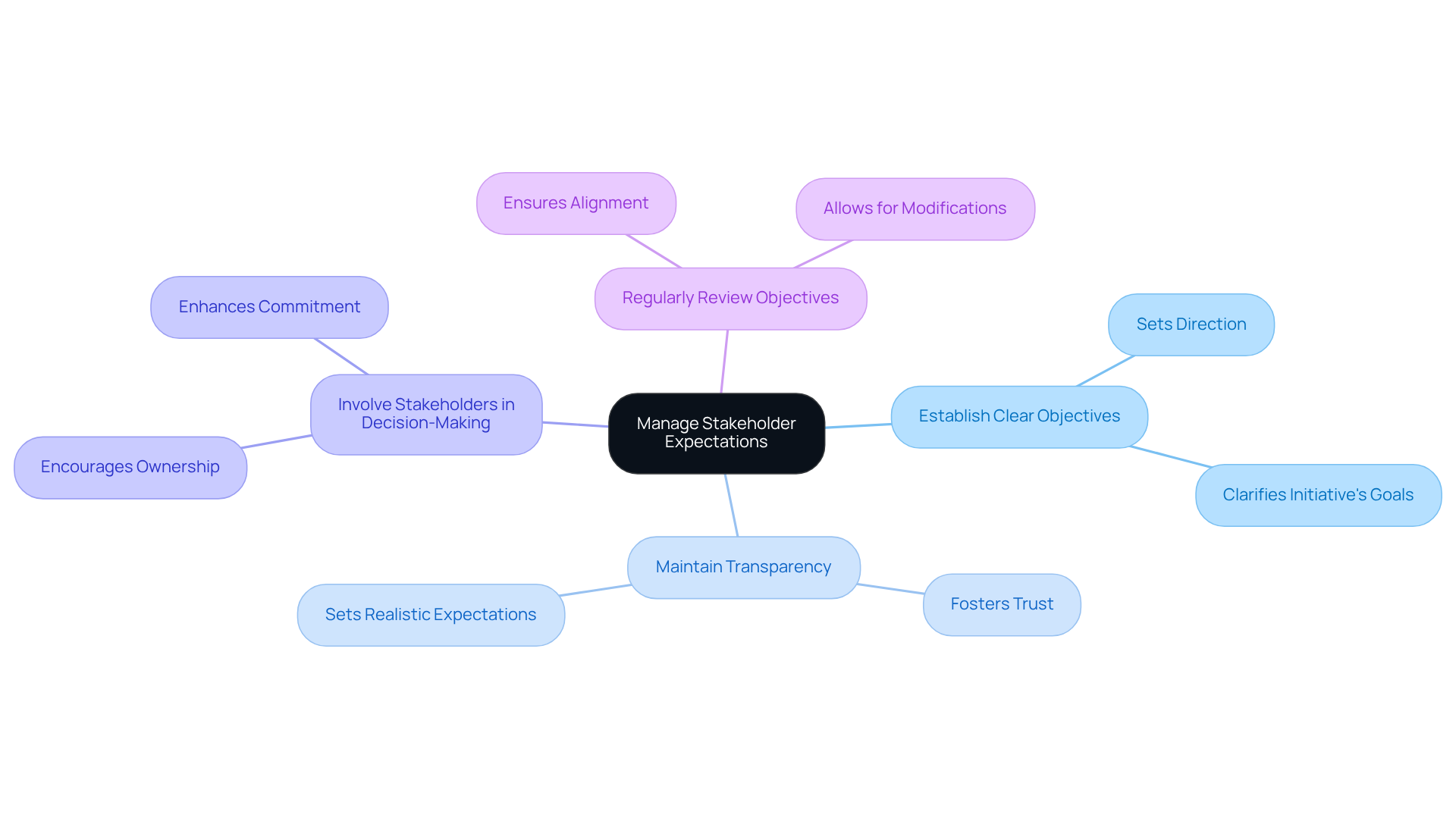Overview
Key practices for project manager stakeholder management encompass:
- Identifying stakeholders
- Establishing clear communication strategies
- Proactively managing their expectations to enhance project success
Effective engagement and communication with stakeholders significantly influence project outcomes. Research shows that initiatives with well-defined participant strategies achieve success rates of 83%, compared to a mere 32% for those lacking such plans. This stark contrast underscores the necessity of implementing robust stakeholder management practices to drive project success.
Introduction
Navigating the intricate landscape of project management requires a keen understanding of stakeholder dynamics. These individuals or groups hold the key to a project's success. By implementing effective stakeholder management practices, project managers can significantly enhance collaboration and drive initiatives toward their objectives. However, the challenge lies in balancing diverse interests and expectations. This raises the question: how can project managers effectively identify, engage, and manage stakeholders to ensure project success? Understanding this is crucial for achieving desired outcomes.
Define Stakeholders and Their Role in Project Management
In the management of initiatives, includes individuals or groups with a vested interest in the initiative's outcome. These parties can be categorized into:
- Primary participants—those directly affected by the initiative.
- Secondary participants—who possess an indirect interest.
Key examples include:
- Sponsors
- Team members
- Customers
- Suppliers
- Regulatory bodies
Recognizing and understanding these roles is paramount in project manager stakeholder management, as the support and involvement of participants can significantly influence the direction and success of an initiative.
Studies indicate that initiatives with clearly defined participant strategies achieve success 83% of the time, underscoring the critical importance of involvement in attaining objectives. In stark contrast, initiatives that lack such plans succeed only 32% of the time. By identifying key participants early in the initiative lifecycle, project manager stakeholder management allows leaders to formulate targeted engagement strategies that address their needs and expectations, ultimately enhancing results and fostering collaboration.
However, common pitfalls in managing interested parties, such as communication breakdowns—which contribute to 19% of failures—must be navigated with care. Moreover, leaders often face challenges in effectively involving various participants, which can complicate the management process. Therefore, a strategic approach to project manager stakeholder management is essential for overcoming these obstacles and ensuring successful initiative outcomes.

Identify and Analyze Stakeholders Using Effective Techniques
To effectively recognize and assess involved parties, coordinators should employ methods such as mapping relationships and utilizing the power-interest matrix. Mapping interested parties visually illustrates their connections to the initiative, while the power-interest grid classifies them based on their degree of influence and interest. This analysis enables project manager stakeholder management by allowing project managers to prioritize relevant parties, especially those with the most substantial influence on project success.
Moreover, conducting interviews or surveys can provide critical insights into participant expectations and concerns, facilitating a more tailored interaction strategy. Research indicates that companies engaging with interested parties are 50% more likely to achieve their primary objectives, and 85% of those involved believe that such engagement significantly impacts their perception of organizational transparency.
Additionally, a case study demonstrated that employing the power-interest grid allowed a team to concentrate effectively, resulting in a 20% increase in success rates, as highlighted in PMI studies. It is also essential to regularly update the participant map to reflect shifts in participant dynamics, as relationships can evolve over time.
By integrating these techniques, project managers can improve project manager stakeholder management and foster success in their initiatives.

Establish Clear Communication Strategies for Stakeholder Engagement
Establishing clear communication strategies is essential for effective project manager stakeholder management, as it defines the frequency, format, and channels of communication with involved parties. Regular updates through meetings, emails, or are crucial for project manager stakeholder management, ensuring that interested parties are informed about project progress and any changes.
Moreover, developing a communication strategy that incorporates project manager stakeholder management by specifying who will convey what information and when significantly assists in maintaining consistency and clarity. By leveraging real-time business analytics, as provided by tools like the client dashboard from , organizations can continuously monitor performance and adjust strategies accordingly.
Furthermore, employing feedback mechanisms such as surveys or discussion sessions is crucial for effective project manager stakeholder management, as it enables participants to express their concerns and suggestions, which further enhances engagement and collaboration.
Want more information? Let's talk!

Manage Stakeholder Expectations Proactively to Ensure Project Success
To effectively manage participant expectations, managers must establish clear objectives and outcomes from the outset. This foundational step not only clarifies the initiative's direction but also sets the stage for ongoing alignment. Furthermore, regularly reviewing these objectives with involved parties ensures that everyone remains aligned and allows for essential modifications in response to changing circumstances.
Transparency regarding potential challenges and risks is crucial; it aids in setting realistic expectations and fosters trust. Moreover, actively involving interested parties in decision-making processes and providing opportunities for their feedback is essential for project manager stakeholder management, as it cultivates a sense of ownership and commitment, significantly enhancing their support for the initiative.
Research indicates that leads to projects being 2.5 times more likely to succeed, underscoring the critical nature of these practices in achieving project objectives.

Conclusion
Mastering the nuances of stakeholder management is essential for project managers who aim to guide their initiatives toward success. By understanding the diverse roles and interests of stakeholders, project leaders can develop engagement strategies that not only enhance collaboration but also align all parties with the project’s objectives. The importance of this practice cannot be overstated; effective stakeholder management serves as a cornerstone of project success.
This article outlines four key practices that are critical for successful stakeholder management:
- Defining stakeholders and their roles
- Employing effective identification and analysis techniques
- Establishing clear communication strategies
- Proactively managing expectations
Each of these practices contributes to a robust framework that empowers project managers to navigate the complexities of stakeholder dynamics. By utilizing methods such as the power-interest matrix and maintaining open lines of communication, project managers can cultivate an environment of transparency and collaboration, ultimately leading to more favorable project outcomes.
In conclusion, mastering stakeholder management practices is paramount for achieving project success. Project managers are urged to adopt these strategies not only to meet project goals but also to foster lasting relationships with stakeholders. By prioritizing effective engagement and communication, project managers can ensure that their initiatives flourish in a landscape characterized by diverse interests and expectations. Embracing these best practices will enable project managers to lead their teams with confidence and achieve remarkable results.
Frequently Asked Questions
What are stakeholders in project management?
Stakeholders are individuals or groups with a vested interest in the outcome of a project. They can be categorized as primary participants, who are directly affected by the initiative, and secondary participants, who have an indirect interest.
Who are some examples of stakeholders?
Key examples of stakeholders include sponsors, team members, customers, suppliers, and regulatory bodies.
Why is understanding stakeholders important in project management?
Understanding stakeholders is crucial because their support and involvement can significantly influence the direction and success of a project.
What is the success rate of projects with clearly defined stakeholder strategies?
Projects with clearly defined stakeholder strategies achieve success 83% of the time.
How do projects without defined stakeholder strategies perform?
Projects that lack defined stakeholder strategies succeed only 32% of the time.
How can project managers enhance results through stakeholder management?
By identifying key stakeholders early in the project lifecycle, project managers can formulate targeted engagement strategies that address the needs and expectations of these participants, ultimately enhancing results and fostering collaboration.
What are common pitfalls in managing stakeholders?
Common pitfalls include communication breakdowns, which contribute to 19% of project failures, and challenges in effectively involving various stakeholders.
What is essential for overcoming challenges in stakeholder management?
A strategic approach to stakeholder management is essential for overcoming challenges and ensuring successful project outcomes.




